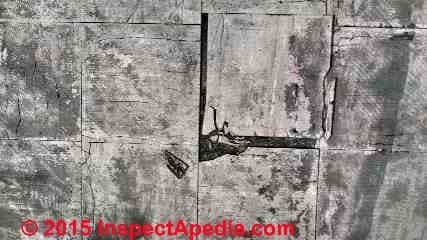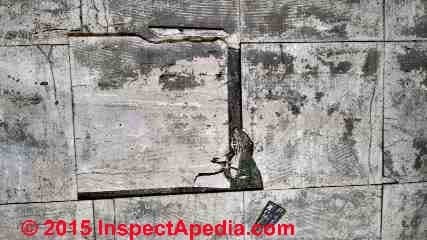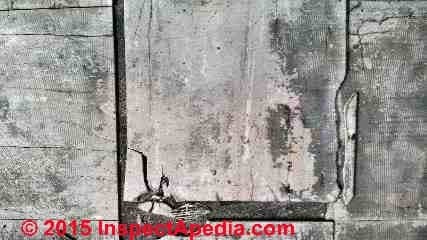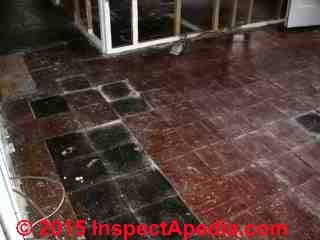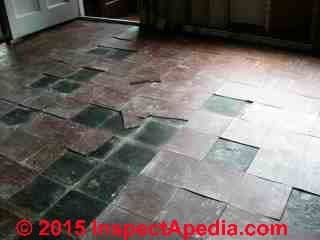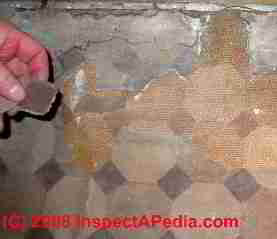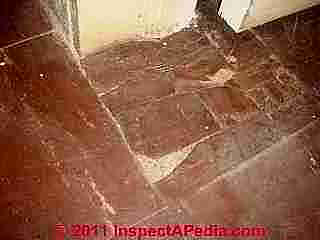 Asbestos
Flooring Hazard levels
Asbestos
Flooring Hazard levels
Determine the hazard level & decide when asbestos-containing floor tiles should be removed
- POST a QUESTION or COMMENT about the actual level of risk of asbestos exposure from asbestos-containing flooring
Asbestos flooring hazard levels:
What is the actual risk level from asphalt asbestos floor tiles, vinyl asbestos floor tiles, or asbestos-backed sheet flooring? How do we decide if asbestos-containing floor tiles or sheet flooring can be safely left in place (and covered-over) or if the material must be removed?
What do asbestos-containing floor tiles in poor condition look like?
This article summarizes the probable risk of asbestos exposure from asbestos-containing floor tiles or sheet flooring as depending on the condition, covering, and location of the floor.
InspectAPedia tolerates no conflicts of interest. We have no relationship with advertisers, products, or services discussed at this website.
- Daniel Friedman, Publisher/Editor/Author - See WHO ARE WE?
What is the Level of Hazard of Asphalt Asbestos or Vinyl Asbestos Floor Tiles?
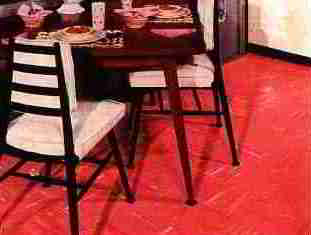 Asbestos is safe and legal to remain in homes or public buildings as long as the asbestos
materials are in good condition and the asbestos can not be released into the air. - US EPA
Asbestos is safe and legal to remain in homes or public buildings as long as the asbestos
materials are in good condition and the asbestos can not be released into the air. - US EPA
The US EPA points out in ADEQUATELY WET ASBESTOS GUIDANCE, EPA340/1-90-019 that asbestos-containing floor tiles are considered non-friable materials but the materials can become friable with age or by grinding, sanding, demolition, etc.
[Click to enlarge any image]
For a quick check and five easy questions that can help tell you if an unknown floor covering contains asbestos, try
DOES THIS FLOORING CONTAIN ASBESTOS?
Article Contents
- ASBESTOS FLOORING HAZARD LEVEL ASSESSMENT
- ASBESTOS FLOOR TILE COMPOSITION - separate article
- DOES THIS MATERIAL CONTAIN ASBESTOS? - 5 easy questions to tell if a BUILDING MATERIAL probably contains asbestos -
Asbestos-Containing Flooring Hazard Level Evaluation
The risk of asbestos particle release and thus asbestos exposure from asbestos-containing flooring depends on several variables that we list here.
- Condition of the asbestos-containing flooring:
Here is what the University of Minnesota has to say about the hazards of this type of asbestos-containing floor tiles:
Flooring that contains asbestos, when intact and in good condition, is generally considered nonfriable and is not hazardous.
Heat, water, weathering or aging can weaken flooring to the point where it is considered friable. Friable flooring includes any material containing more than 1 percent asbestos that can be crumbled, pulverized or reduced to powder with hand pressure.
This includes previously nonfriable flooring material which has been damaged to the extent that it may be crumbled, pulverized or reduced to powder by hand pressure.
Flooring can also be made friable during its removal. Friable materials can release asbestos fibers into the air. Once in the air, asbestos fibers present a health hazard to people who inhale those fibers.
Really? Well not all asbestos-flooring damage is dangerous: minor damage such as a small scratch in an otherwise intact asbestos-suspect tile or sheet flooring will not produce measurable airborne asbestos hazards.
See ASBESTOS FLOORING DAMAGE HAZARDS. - Asbestos-containing floor tile or sheet flooring color, ingredients, composition vary in asbestos content: as we discuss
at ASBESTOS FLOORING IDENTIFICATION, depending on the particular mixture of asphalt, gilsonite, asbestos, limestone, and pigment used, these floor tiles could contain as much as 70% asbestos by weight.
One reason that so much asbestos was used in flooring tiles was simply the wish to find an application for asbestos waste product from asbestos mining operations. - Location of asbestos containing floor coverings:
an asbestos containing or presumed asbestos containing floor covering that is in a low-traffic area, in good condition, is not a significant hazard to building occupants. In a high traffic location where a floor is subjected to wear, abrasion, abuse, the risk will be greater. - Coverings over asbestos-containing flooring:
if the asbestos-floor tiles or sheet flooring have been painted, coated with a sealant, or floored-over using carpet, laminate, or any other continuous flooring so that the original floor is not exposed, the risk level provided by the original asbestos-containing flooring is low to beneath the level of detection in the building. - Methods used to leave in place (least risk), repair, or remove (most risk) asbestos-containing flooring.
If removing or renovating asbestos-containing flooring or flooring that is presumed to contain asbestos (PACM), don't use grinders, sanders, or demolition methods that break up flooring into many small pieces.
See ASBESTOS FLOORING HAZARD REDUCTION for details.
Also see ASBESTOS REMOVAL, WETTING GUIDELINES.
Asphalt asbestos floor tiles as an asbestos fiber source in buildings
Asphalt asbestos floor tiles were popular in the U.S. from 1920 into the 1960's. Asphalt-asbestos floor tiles were produced at first in dark colors using a heavy asphalt binder combined with a very high percentage of asbestos filler fibers, principally chrysotile and amosite asbestos.
See ASBESTOS FLOOR TILE COMPOSITION.
It would be uncommon to find these floors still in use today, but if you encounter black or very dark asphalt floor tiles they are probably very high in asbestos fibers.
Source of High Levels of Asbestos in Asphalt Floor Tiles:
Asphalt-asbestos floor tiles were produced at first in dark colors using a heavy asphalt binder combined with a very high percentage of asbestos filler fibers.
It would be uncommon to find these floors still in use today, but if you encounter black or very dark asphalt floor tiles they are probably very high in asbestos fibers.
 Depending on the particular mixture of asphalt, gilsonite, asbestos, limestone, and pigment used, these floor tiles could contain as much as 70% asbestos by weight.
Depending on the particular mixture of asphalt, gilsonite, asbestos, limestone, and pigment used, these floor tiles could contain as much as 70% asbestos by weight.
One reason that so much asbestos was used in flooring tiles was simply the wish to find an application for asbestos waste product from asbestos mining operations.
The black and white floor tiles at left also may be vinyl not asphalt based since white tiles appear to have been laid at the same time as the black units. This home was constructed in the 1950's.
Since white resilient floor tiles would have been unusual to find before 1952-1955, we guess that the age of the floor may be consistent with that of the home in this photo.
While the asbestos fibers are mixed with a hard binder and the floor tiles are certainly not friable, we have read accounts of airborne levels of asbestos fibers being traced to the presence asphalt-asbestos floor tiles in areas either subjected to high volume foot traffic or to abrasive floor cleaning or maintenance procedures (like using steel wool pad floor buffing machines in a school corridor), or during demolition of this material.
Older nine-inch "thicker" vinyl or asphalt-based floor tiles, many more recent 12-inch floor tiles (1960 - 1980), and some more recent sheet linoleum as well as the mastic used to bed or glue down older flooring materials are likely to contain asbestos fibers and should not be disturbed by grinding, sanding, or demolition without taking the appropriate precautions.
We discuss the history and manufacture of asphalt-asbestos floor tiles in our Age of House articles
at FLOORING MATERIALS
We discuss the inspection, diagnosis, and repair of various flooring products
At CERAMIC TILE, ASBESTOS / LEAD? we address the question of whether or not other forms of flooring such as ceramic tile contain an asbestos hazard.
Also see ASBESTOS DUCTS, HVAC a field identification guide to visual detection of asbestos in and on heating and cooling system ducts and flue vents.
Also see MICRO-PHOTOGRAPHS OF DUST FROM THE WORLD TRADE CENTER collapse following the 9/11/01 attack. Links to U.S. government and other authoritative research and advice are included.
Examples of Asbestos-Containing Floor Tiles in Poor Condition
In addition to the page top photo of cracked loose asbestos-containing floor tiles, the reader below has sent additional examples of damaged asbestos floor tiles.
Even for these examples of damaged tile flooring we need to answer a few questions before determining that professional removal by an asbestos expert is necessary.
Reader Question: do these floor tiles contain asbestos?
My wife and I recently ripped up a rug in our small breeze way and planned on putting down tile.
When I ripped up the rug I found that there was previously old tile, some of which was cracked and brittle.
Attached below are the pictures of the tile. Our house was built in the 1950's and I am concerned that the tile might contain asbestos.
The tiles are 9 x 9. Do these tiles contain asbestos? - M.D., Connecticut, USA, 26 Jul 2015
Reply: This floor is most likely an Armstrong 9x9 asphalt asbestos floor tile from the 1950's or 1960's.
Congratulations on sending along some of the most smeared over and breaking up Armstrong vinyl asbestos (or possibly still older asphalt asbestos) floor tiles I've seen in a while.
Take a look
at ASBESTOS FLOOR TILE IDENTIFICATION PHOTOS 1949-1959
where you will
find
Navaho Gray 781 Armstrong asphalt asbestos floor tiles from the 1950's that look quite like your example photos.
It would be prudent to treat the flooring as "PACM" or "Presumed Asbestos Containing Material" as I am virtually certain they are.
That does not mean we should panic nor that in all cases we need to undertake an expensive and dangerous asbestos removal project.
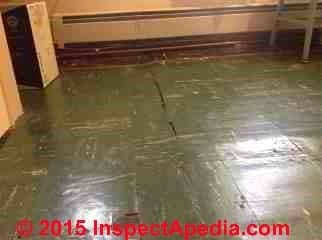
Asbestos is safe and legal to remain in homes or public buildings as long as the asbestos materials are in good condition and the asbestos can not be released into the air.
Generally the safest approach is to leave such flooring alone and to cover it over with a coating or with another layer of flooring.
The Armstrong asphalt asbestos floor tiles shown at above-left are probably Armstrong's Osage Green
(see ASBESTOS FLOOR TILE IDENTIFICATION PHOTOS 1949-1959) and may be in good-enough condition that a floor can be installed overtop.
A quick catalog of green Armstrong vinyl asbestos floor tiles is at
However the tiles in your photos shown earlier on this page and in another example shown just below look rather broken up, enough that some cleanup is probably necessary.
Watch out: the tile mastic in these older asbestos-tile flooring systems also may contain asbestos.
Don't let an unqualified contractor create a dusty demolition mess or the ultimate costs may increase by the need to clean other areas of your home where asbestos containing dust may have been transported.
On any of our asbestos-related InspectApedia pages, at CONTINUE READING you will find a complete
ARTICLE INDEX to ASBESTOS HAZARDS
See therein
ASBESTOS FLOORING HAZARD REDUCTION.
For a floor that is mostly securely glued down
see ASBESTOS FLOORING LEFT IN PLACE. It is often the case that one can install a new layer of flooring atop the existing secure floor covering; if there are small uneven areas where tiles have been lost those may need to be filled in with a masonry leveling compound.
Other flooring systems such as floating clip-together laminate or engineered wood floors are easily installed atop a rosin paper layer placed over the older floor.
For an asbestos tile or sheet floor that is is so badly uneven and broken up or loose (such as the water-damaged floor above) that you cannot seal and floor-over it, then see
ASBESTOS FLOORING REMOVAL GUIDE
Watch out: Meanwhile do not run a vacuum there unless it's HEPA rated as you may increase the hazard of airborne dust that might contain asbestos.
IF you want to have flooring a sample tested
see ASBESTOS TESTING LAB LIST and
if you need help collecting a flooring test sample
see ASBESTOS TESTING SAMPLE COLLECTION.
We would much appreciate hearing any comments, critique, suggestions, or further questions that you may have after you've taken a look at the articles I've cited.
Advice on Removing Asbestos-containing Asphalt or Vinyl Floor Tiles
Details about asbestos-flooring product removal are
at ASBESTOS FLOORING REMOVAL GUIDE; excerpts are below.
The green Armstrong asphalt asbestos floor tiles shown at left are located in a business in Two Harbors Minnesota and are in poor condition.
[Click to enlarge any image]
- First choice: consider simply installing a new material atop the old instead of removing asbestos-containing flooring. Remember that asbestos is not "radioactive" - it does not cause injury or illness simply by being present, encapsulated in a substance or covered-over by a new material.
See ASBESTOS FLOORING LEFT IN PLACE
and
see ASBESTOS FLOORING HAZARD REDUCTION
The University of Minnesota source (atReferences or Citations ) includes advice on removing asbestos-containing floor tiles if removal is required for any reason, and the UM provides examples of do-it-yourself removal procedures that are safe for homeowners as well as examples that were probably unsafe or improper. - In general, avoid violent demolition, such as using floor sanders, grinders, or floor stripping machines to remove these materials.
- During demolition or removal, this material should be disturbed as little as possible.
- In most residential cases testing these floor products is probably not justified,
but if you prefer to send asbestos-suspect material samples to an NVLAP certified lab, they usually want three separate samples each about 3/4" in diameter, and charge about $20./sample.
Here is the NIST link about those labs: http://ts.nist.gov/Standards/scopes/temtm.htm that has a list of participants. NVLAP is a national voluntary lab accreditation program within NIST (National Institute of Standards and Technology)
NIST is a non-regulatory federal agency within the U.S. Department of Commerce whose lab program is at http://ts.nist.gov/Standards/Accreditation/index.cfm - For guidelines for wetting asbestos containing materials, see
ADEQUATELY WET ASBESTOS GUIDANCE, EPA340/1-90-019 that asbestos-containing floor tiles are considered non-friable materials but the materials can become friable with age or by grinding, sanding, demolition, etc. - ASBESTOS FLOORING HAZARD REDUCTION - things you can do to minimize asbestos particle or fiber release from an existing asphalt asbestos or vinyl asbestos floor: tiles or sheet flooring
- ASBESTOS FLOORING REMOVAL GUIDE - how to remove asbestos-containing flooring while minimizing the asbestos release or exposure hazard
Antique Linoleum, Jute-Backed: not an asbestos product
This sheet flooring covering backed with burlap fabric is probably more than a century old.
The material has not been tested for asbestos fibers, but where we see what is obviously a jute backing it's not likely that the product contained asbestos..
The possible origin of this product is discussed
at ASPHALT & VINYL FLOOR TILE HISTORY - history, dates, and description of the production process and ingredients in asphalt floor tiles, asphalt-asbestos floor tiles, & vinyl-asbestos floor tiles 1900 to present.
Asbestos-containing flooring was sold in both individual floor tiles and in rolls of sheet flooring. But just as with vinyl or plastic floor tiles, not all flooring contains asbestos.
LINOLEUM & Other Sheet Flooring includes examples of sheet flooring that often did not contain asbestos.
To treat floor coverings in asphalt-based floor tiles or sheet flooring, or vinyl (plastic)-based floor tiles or sheet flooring, it is reasonable to treat flooring sold even into the early 1980's as PACM (Presumed Asbestos Containing Material).
Also the mastic or adhesive used to install flooring may also contain asbestos.
Keep in mind also that very often it is not necessary nor even recommended to remove PACM floor coverings. But if conditions require that it be removed,
see ASBESTOS REMOVAL GUIDE, FLOORING.
How to Dispose of Vinyl-Asbestos or Asphalt Asbestos-Containing Floor Tiles
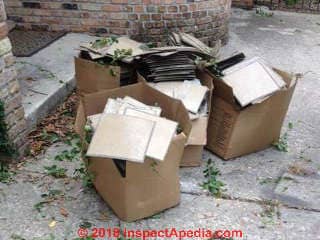 The following advice for disposal of vinyl-asbestos or asphalt asbestos floor tiles is adapted from the Minnesota State Department of Health:
The following advice for disposal of vinyl-asbestos or asphalt asbestos floor tiles is adapted from the Minnesota State Department of Health:
State health departments typically recommend that all asbestos debris and waste is disposed of in a landfill that accepts asbestos-containing waste.
There are three methods of disposing of asbestos waste and they are:
- Contact local waste hauler for special pick-up.
- Contact licensed abatement contractor for pick-up and disposal.
- Dispose of waste yourself.
Watch out: if you are disposing of asbestos-containing waste yourself, you should contact your local state health department for detailed instructions.
For example, while a landfill may accept asbestos-containing-material (ACM) (as the material may be buried and thence non-hazardous, special requirements may apply to protect workers and buildings from asbestos dust during collection, bagging, removal, and transportation.
- Ref: MN DPH atReferences or Citations
InspectAPedia.com is an independent publisher of building, environmental, and forensic inspection, diagnosis, and repair information for the public - we have no business nor financial connection with any manufacturer or service provider discussed at our website.
...
Reader Comments, Questions & Answers About The Article Above
Below you will find questions and answers previously posted on this page at its page bottom reader comment box.
Reader Q&A - also see RECOMMENDED ARTICLES & FAQs
Question: How much asbestos hazard was I exposed to during our floor renovation project?
We recently partially demo'd a ceramic tile floor in the kitchen of a home built in 1970. We popped the ceramic tiles up with a pry bar and sledge hammer. Beneath the tiles was a linoleum floor covering. I've visually identified the flooring on your website. It is Armstrong, Excelon, Custon Burnham 1972, 57080 Blue.
How much asbestos does this contain? Also, we didn't bother peeling it all up because it was too difficult.
We chipped up the remaining ceramic tile on top of it and just covered the remainder of the floor with plywood and fastened the plywood with split drive fasteners. We then nailed pine plank flooring over the plywood. Do we have any reason to worry about asbestos exposure?
My husband wore a dust mask. - Kelly McCullin 11/13/2012
I have ArmStrong sheet layment in my kicten.There was a layer of newer layment on top I did realize it was the orignal under it. The house was built in 1974. I removed about a there foot area before I realized it. If i was exsposed to it how much does it take to make you sick and what are the symptoms.I have to think I am not the only one who has done this. - David 11/28/2012
Reply: it depends ... List of risk factors when removing flooring that may contain asbestos
David, and also Kelly McKullin:
Unfortunately no one can say with any accuracy whatsoever just what level of hazard you were exposed to during your asbestos floor removal. The variables include:
- the total amount of material disturbed and removed
- the actual asbestos content of the flooring and of other materials, such as mastic, that were disturbed
- the removal methods used to take up flooring, and just how much dust you created
- nature of demolition dust and debris - particle size, therefore airborne particulate levels & duration of particles in the air. For example, picking up a whole floor tile that is already loose may produce almost no detectable airborne particulates, while running power tools, saws, grinders, sanders, hammers, can make a lot of dust
- dust control measures used during the project
- cleanup methods used after the project both in and out of the work area
- remaining dust that could have led to longer term exposure
- individual health history, respiration rate, personal protective gear used or not
- other site & individual -specific data not listed here
If you have specific individual health questions those should be posed to your doctor who knows your personal health history
Presuming that your project is now long over, if you have reason to be concerned, you might want to do some strategic dust sampling to see whether or not the building needs further cleanup
See ASBESTOS REMOVAL GUIDE, FLOORING and ASBESTOS REMOVAL, WETTING GUIDELINES
Question: should I be worried about this Armstrong Floor tile found in my house - built in 1990?
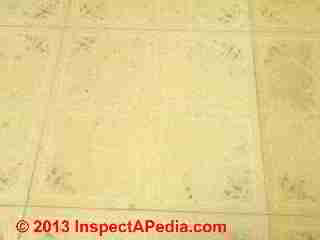 This tile is on my kitchen floor. I started to demo, but found that some tiles contain asbestos.
This tile is on my kitchen floor. I started to demo, but found that some tiles contain asbestos.
I have screened your site over and over and do not see it.
The house was built in 1990 and the tile has an Armstrong print on the back.
Could you help me any? - J.M. 3/13/13
Reply: not much
JM
it would be very very odd for a home built in 1990 to have included asbestos-containing floor tiles unless some eccentric builder was using up "new old stock" hidden away somewhere from the 1970's.
I suggest you can rest easy about asbestos from the tiles, and as you're describing what is surely a non-brittle vinyl product the most mess you'd make during demolition would probably be from surrounding dirt or tile mastic.
Watch out nevertheless: it is always smart to use good dust control measures - lots of demolition debris particles are irritating, allergenic, and sometimes worse regardless of an asbestos hazard.
On 2021-02-13 by (mod) - asbestos in some asphalt-saturated felt or "roofing felt"
That black paper "stuff" may have been asphalt saturated "felt" - basically a paper product used as a cushion and vapor barrier. Some of those products contained asbestos.
I addressed the usual concerns for "concrete" stuff in my earlier remarks. Once the horse has run-off, leaving her rider standing in the barnyard, worrying about whether or not the saddle cinch-strap was sufficiently-tight isn't of much use, while the worry itself may be a health hazard.
Clean up any remaining dust as I described; If you have health worries those are best served by a review with your doctor.
On 2021-02-13 by Carol
We were wearing masks most of the time. The black stuff was like a thin paperlike stuff, like wallpaper almost. Then there was metal mesh that was very sharp filled with concrete like stuff.
Then the small blue ceramic like tiles you see in my photo. The floor was really tiny 1 inch ceramic or porcelain like tiles. I’m really worried about what the concrete stuff was made of.
On 2021-02-13 - by (mod) -
Gee I can't say for sure but I think we're looking at ceramic tile;
Is that black material an asphalt-based adhesive? If so it may contain asbestos; usually not very friable,
But in any event the dust from demolishing even ceramic tile with a sledgehammer is likely to be a health hazard; be sure you're wearing appropriate protective gear, doing dust control, and cleaning up thoroughly - damp wipe and HEPA vac adjoining areas at the end of this job .
On 2021-02-12 by Carol
We demo’d my moms 1967 master bath and didn’t think about asbestos. Does any of this look like possible tile that would contain it?

On 2020-11-08 by (mod) - is air testing useful to assess risk after I ran a vaccum cleaner on asbestos-suspect debris?
Anon
In my opinion are testing would not be helpful in the case that you described. That's because I don't know and you don't know what harmful dust may have settled in various areas of the building and because air testing is very inaccurate when used as a building "screen" for particulate contaminants, showing many orders of magnitude variation in results depending on even small changes in how such a "test" is conducted.
An example of this problem is detailed
at AIRBORNE MOLD COUNT VALIDITY
If it were my own project I might sample an area of settled dust that represents the dust from the time of disturbance of the floor such as horizontal trim over a window or door.
There I would collect one or two representative adhesive tape samples to have processed by a certified asbestos test lab. If they tell you that there is significant levels of asbestos in your dust then you will know that you need some additional cleaning.
On 2020-11-08 by Anonymous
I have asbestos tiles in the basement and recently had a company place a sump pump. It was dusty and dirty so I vacuumed (prob the worse) thing I could do now that I know. I’m super paranoid and wondering if I can get the air tested.
Do you suggest sealing it before laying a water proofing flooring over it? I have 2 small children and am freaking out. Is there anything else besides throwing the vacuum away that I can do? Thanks.
On 2020-09-15 by (mod) - made the mistake of using a tile removing machine
I can't assess the actual asbestos risk based on a brief note, Carlos, but both silic dust and other fine ceramic dust and debris can be harmful, whether it contains asbestos or not.
To allay your asbestos concern you might simply use our ADHESIVE TAPE TEST to collect a sample or two of representative settled dust from in and out of the work area that you then send to an asbestos test lab. That'll tell you if more cleaning is needed.
On 2020-09-15 by Carlos
Hello, I recently made the mistake of using a tile removing machine.. with the sharp blade to remove old tile from my basement. The house was built in 1960. The tile floor got broken into pieces. Later a friend and friend mentioned it could be asbestos, long story short. I sent in a piece to get tested, and came back 2%. .. The glue was non asbestos.. I have kids I’m the house so I’m worried..after the removal we floating floor in the basement. Should I be worried being 2% asbestos??
On 2020-07-11 by Joe
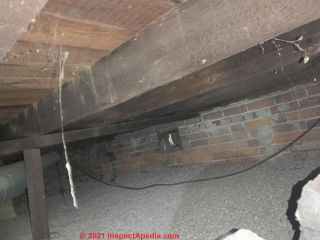 thank you very much for your informative and detailed reply!! I am very grateful.
thank you very much for your informative and detailed reply!! I am very grateful.
I did not know that about [some genera or species of mold spores or other fungal material - Ed.] being toxic even when dead [as they may, for example, contain mycotoxins -Ed.] ! Good to know and I will make sure to keep that in mind.
I think removing all layers of flooring (very carefully!) is going to be a long-term solution and I will feel much better about the whole thing. ( I forgot to mention in my original post that all cabinets, appliances, etc. have been removed from the area, to reduce risk of contaminating those while working on the floor).
The house sits on 3 crawlspaces and 2 sections of full-height basement. There are openings into each crawl space from the main basement via cutouts in the stone walls. Not my favorite places to be, but I can get into the crawls if needed. I'v included a photo of the crawlspace under the kitchen floor.
That wire you see hanging is electric running out to the detached garage...the house's electric is a whole other project and I have an electrician on tap to deal with that.
The kitchen was an addition (maybe 1930s or 40s?) and has mostly a brick foundation on top of I’m-not-sure-what and a portion of the side wall sits on the original stone foundation.
Years ago we had all of the crawls cleaned out and layered with gravel.
The main basement areas have concrete floors and stone walls. We had french drains installed throughout the basement and added a larger sump well and pump.
There is some moisture wicking through the foundation down low in two corners of the basement (next project!) but the crawls are about 5 feet higher and stay pretty dry. We don’t use the basement as a living space or for storage or anything but the furnace, water heater, water softener, breaker box…
We also installed underground pipes around the outside of the house to catch the drainage from the roof downspouts and send it all to the storm sewer.
There is some air circulation in the basement/crawl spaces through general purpose fans, open windows (when it’s not humid), de-humidifiers, and through old half-hazardly covered crawlspace vents and the stone foundation.
Question: what's the best way to install ceramic tile over a leak-damaged, multi-layer moldy floor that includes asbestos floor tiles?
2020/07/10 I have a victorian house and in the kitchen (small, about 200 sq ft) there are several layers of flooring.
Layers of flooring, bottom up
- 1st Layer: Hardwood 5" planks on joists over crawlspace (no subfloor).
- 2nd Layer of some sheet linoleum type, asbestos-free
- 3rd Layer of linoleum type, asbestos-free.
- 4th Layer, Vinyl tiles = 1- 3% asbestos adhered with 3-5% asbestos-containing mastic over non-asbestos fibrous underlayment
- 5th layer, 1/4" luan plywood
- 6th layer - sheet vinyl - circa 2005 (removed)
- Replacement 6th layer: (circa 2010) floating vinyl tiles that adhere to each other by overlapping sticky strips. (Removed)
PROBLEM: Water got under those 2010 vinyl tiles
in a few places and mold grew in patches. I discovered this by accident when installing new cabinets.
So, I carefully cleaned the mold, and removed the floating tiles, found the mold had gone down through the luan and even onto the asbestos vinyl tiles. Carefully cleaned and removed a 4 x 4 ft section of luan and bleached the heck out of the remaining floor. Kept it wet and covered with plastic sheeting during cleaning and removal.
So.. now I want to put ceramic tile down and avoid any further water issues.
The section of the old layer of asbestos-containing tiles (1-3%) where the luan has been removed are not in great shape and the mastic is showing through in places. There are old rusty staples in some places, not very deep, but not sure what they were holding (I don’t think it’s the luan).
I have kept the area covered with plastic and have not been using the room while researching options.
With so many layers of flooring, combined with a worry about mold returning, I really would rather just remove it all rather than try to find a way to lay tile and have it be stable over all of that mess.
IS IT POSSIBLE TO REMOVE ALL the FLOORING REASONABLY SAFELY
If I completely shut off the kitchen with plastic sheeting over all entries, cover the floor with plastic sheeting and work under that in small sections while keeping the layers wet, wear a correct respirator and suit, gloves,etc., would it be reasonable to remove all of the layers by:
Scraping from under the non-asbestos layer and carefully breaking those non-asbestos layers at the seams of the asbestos-containing tiles?..These non-asbestos layers under the hard asbestos-containing tiles are mushy.
I would wrap each removed section with plastic and seal with tape.
Or, what do you suggest?
Moderator reply: control the dust, remove all the old flooring, reinforce the base floor, dry out the crawlspace before installing ceramic tile
Joe
Actually that sounds like a reasonable procedure to me. It's the wetting and dust control and personal protection that are most-important.
In general: in my OPINION and experience, water seeps between de-laminated or poorly-adhered layers of flooring, so mold can grow in those areas.
But in a leak event, water doesn't enter far between layers of adhered non-porous (themselves) materials. One could dry out and seal such areas figuring that there won't be an ongoing mold growth problem in the absence of moisture; a few mold spores at the edges of sealed areas are beneath the limits of detection of a hazard.
But on the other hand, your kitchen's 6-layers of flooring include 5 interstitial spaces, probably not sealed with adhesive, between layers 1-2, 2-3, 4-5, and 5-6.
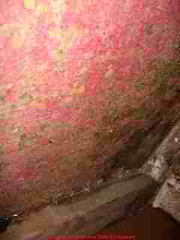 Water that penetrates those areas will eventually dry out - but it can take more time than one might imagine
Water that penetrates those areas will eventually dry out - but it can take more time than one might imagine
As a point of reference, in multiple field investigations I've often found palpably-wet wood and drywall between floor baseboard trim and the bottom of wall drywall a month after a wet-floor event that was "cleaned and dried by a water extraction company",.
I've found gross rampant mold thick in wall cavities above such an area five months later when the company left previously wet materials in place.
My photo shows what the wall cavity looked-like when I opened it.
More examples are
at RED MOLD PHOTOS - the photo above, and also
at HIDDEN MOLD in CEILING / WALL CAVITY
and
at HIDDEN MOLD in FLOOR / SUB-FLOORING
Prevent future Cracks in Ceramic Floor Tile
Worse, in my experience, is the result of installing ceramic tile over such a multi-layered floor without an absolutely solid, rigid substrate.
Any spots of more than a couple of inches that become soft and mushy as layer #5 (luan) or #1 (wood) deteriorate from water left therein ultimately telegraph their presence as cracks in the new top layer of tile.
Your "keeping it wet" keeps down dust but adds to the water-penetration risk.
Your use of bleach is something I might do too, but honestly it's misguided. The object of "killing mold" appeals especially to certain of us of a particular political stripe, but it's wrong.
"Dead" mold spores simply won't propagate (provided you could kill 100 % of them - which is impossible) but "dead" mold spores, depending on their genera-species, are still toxic, bearing mycotoxins into anyone who inhales them later.
Properly we
1. remove the mold and
2. fix its cause and therefore
3. prevent its recurrence.
That topic is addressed
So if this were my project I'd remove those layers of flooring down to the original, clean and dry the remains, including the bottom of the surrounding wall cavities, add additional solid-core plywood underlayment to have sufficient stiffness that your ceramic floor tiles wont' flex and crack, and be done with it.
Watch out: crawl spaces are where often the worst building problems of leaks, rot, insect damage, and mold develop, because they're either inaccessible or are difficult to access, or are so nasty that nobody ever looks into them. Do not do all of the work outlined in our discussion without a thorough investigation of the crawl area and its conditions.
If there is no other crawlspace access, then when you're down to the original wood flooring it's trivial to at the very least cut an opening sufficient to get into that space for inspection.
Let me know what you find and how that crawl space is constructed, kept dry, etc. and we can discuss that further.
Photos of all of this would be helpful (one per comment).
CRAWL SPACE DRYOUT and other articles in that series are worth a look.
On 2020-05-23 - by (mod) - is this asbestos-backer on sheet flooring?
 By eye, alone, Shellly, no I can't say that your flooring does or doesn't contain asbestos.
By eye, alone, Shellly, no I can't say that your flooring does or doesn't contain asbestos.
But based on the age and the white sheet flooring backer it would be smart to treat the floor as presumed to contain asbestos.
On 2020-05-23 by Shelly
Hi this home condo is built in the 83. Vinyl floor has a patterned layer upon another white layer and particle board below.
I am wondering if you recognize as one of the Asbestos patterns or if the white adhesive looks like it contains the fibers.
On 2020-03-10 - by (mod) -
Joseph:
What was the sample sent to an asbestos test lab? Carpet, flooring, house dust?
Unfortunately one can't assess the actual dust exposure level from your report.
What you can do is have the area properly cleaned of dust: damp wiping, HEPA vacuuming.
And you can take the remaining health questions to your doctor. People who are elderly, infant, immune impaired, asthmatic, have COPD, etc. are of course at greater hazard from general dust exposure.
On 2020-03-10 by Joseph Ellis
6 months or so ago my wife tore up the carpet in our toyroom and found another layer before the old wood. She tore that up too, with the kids helping to haul it all outside etc. They then swept it all up, vacuumed, and then returned all the toys to the room. Neither of us had ever heard of asbestos in flooring.
Recently she ran into an article about it and sent samples to a lab per a lot they sent to us. It has 2% asbestos. So she and the kids have all been exposed to the demolition dust etc. I don't blame her, as I would have ripped it out as well, having no clue of the danger. But that's where I'm stuck. What is the danger?
We have the room closed off for now, but how concerned do I need to be for them?
On 2020-02-12 - by (mod) - safe way to remove loose damaged asbestos-containing pebble pattern vinyl-asbestos floor tiles
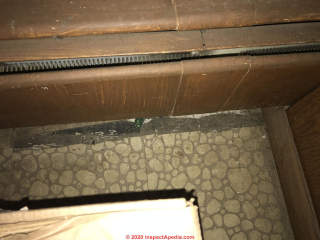 Peter,
Peter,
The best approach is to pick up loose bits of flooring, damp wipe, HEPA vacuum, and leave the rest of the floor in place.
As long as the tiles are securely adhered to the slab or sub-floor that's the safest and most-economical approach.
If you want to minimize dust when pulling staples use and adjacent HEPA vacuum cleaner.
More details are at ASBESTOS FLOORING HAZARD REDUCTION things you can do to minimize asbestos particle or fiber release from an existing asphalt asbestos or vinyl asbestos floor: tiles or sheet flooring
On 2020-02-12 by Peter
Hi:
Thank you for the response. Sorry, I hit "comment" too early when I posted this and did not get to finish what I wanted to say. I emailed your site with a bunch more photos, and a much longer history of my problem. I will try to be brief here.
Some of the tiles in other parts of the downstairs (mostly along the edges, from what I am able to see) are cracked (see new photo), or have holes punched in them (which you can see in the first photo if you look close).
More problematic, are the partition walls--which are probably drilled into the floor (see new photo, the wall on the right is a partition), through the tile--the tack strips, and metal carpet-doorway strips, which are nailed into the tile (I think the holes in the original photo might be from tack strips having been removed in the "art studio,") and the old carpet padding that is stapled into the tile.
If I want to renovate the downstairs, partitions, tack strips, old carpet padding etc. will need to be removed.
Is there a safe way to do this without a professional abatement?
If possible, I was planning on having carpeting put over the floor after the remodel, are there extra precautions I would need to take prior to doing this? Thanks again for your time.
On 2020-02-11 - by (mod) - pebble-pattern vinyl asbestos floor tiles ca 1969
Yes, that looks like an asbestos floor tile. If it's all securely adhered as it is in your photo your best approach is to leave it in place and simply cover it over.
On 2020-02-11 by Peter
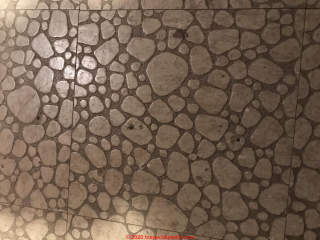 Hi:
Hi:
I've asked a couple of questions on your site recently. It's a great resource and I appreciate the time that you put in to other people's problems.
My house is a high ranch built in 1969 in southern NY.
The downstairs is in need of a remodel...at some point. The problem is that the downstairs has asbestos tile (I have not had it tested, but it matches a photo in your archive) directly on the slab.
Some areas downstairs have a mixture of newer (though still old) carpet over the tile, on tack strips. VERY old shag carpet over the tile on tack strips (and old padding that is stapled into the tile).
What looks like linoleum flooring in the bathroom, exposed tile in the utility room (orange walls in picture) and exposed tile in the previous owners "art studio."
On 2019-10-23 - by (mod) - black asphalt-asbestos floor tile hazard
Kathy:
With the apology that an exactly precise answer would require actual tests and measurements - something not at all cost-justified for the case one can see and read in your photo and message - in general, the first person you spoke with is the more-correct one.
Your flooring is not friable and so not particularly dangerous if not abused; but when you see a couple of cracked corners or tiles it makes sense to cover or stabilize those areas.
Asbestos was used as a strengthening fiber and in very fine particles as a filler in asphalt-asbestos floor tiles. Such tiles are not friable - that means mashing a bit of flooring between thumb and forefinger you could not smush a tile into powdery dust that would then become easily airborne.
By "Abused" I meant that chopping, violent demolition, grinding, sanding or sawing asbestos-containing flooring is unsafe because those processes produce fine dust and powder that would contain asbestos particles and that could travel in the building in air or on foot or on clothing and that could be inhaled.
Schools, charged with being extra cautions with asbestos-containing flooring, learned to avoid using steel floor buffing pads and other floor "cleaning and polishing" methods that were aggressive enough to possibly grind off some of the floor surface.
OPINION: The amount of asbestos released from stepping on 1 cracked asphalt asbestos tile such as in your floor below is most likely to be below the limits of detection in a normal residential setting; however you can minimize the potential hazard by pouring a clear or black filler in and over the cracked area to stabilize it. Or you could pour in a bit of black epoxy floor paint.
See details at ASBESTOS FLOORING HAZARD REDUCTION - things you can do to minimize asbestos particle or fiber release from an existing asphalt asbestos or vinyl asbestos floor: tiles or sheet flooring
I think the person who reports that asbestos dust from a single crack sticks to your shoe and then contaminates an entire house is spending your money to reduce their risk (that their advice wasn't sufficiently cautions).
It's technically reasonable that a small amount of asbestos dust might stick to a shoe sole and be tracked elsewere, but from a single tile on a generally clean floor? I pose that the asbestos dust contribution to the rest of a building in that scenario is below the limits of detection.
On 2019-10-23 by Kathy
Can a cracked asbestos tile be dangerous in that walking on it will transfer asbestos particles to other areas of a house or building?
I have one inspector who says no. He said not unless it is sanded or ground down because the asbestos is locked into these tiles and it does not spread that easily.
Another (who did not see the floor) said that any minor crack or break can leave asbestos residue on a shoe that can contaminate an entire house or building. Who do I believe?
On 2019-10-12 - by (mod) -
2019/10/10 Kim said:
Hello,
We’ve recently been having trouble with our cat urinating on the foyer/living room carpet and have had to repeatedly clean it with a carpet cleaner. My husband and I decided to see what it would take to install hardwood floors and when someone came by to do an estimate he discovered classic 9x9 asbestos tile underneath. I am totally at a loss for what to do at this point because of several reasons:
1) we have two small children and another on the way
2) I have no idea what the condition is of the tile under the carpet and if it’s very damaged could contaminate the house if the carpet gets pulled
3) I fear I could have compromised the tile in the place where I cleaned the carpet most thoroughly because it took several days to dry (and therefore was wet on the tile for awhile - this was all before I knew the tile was
underneath), causing the tile to potentially become brittle or crumbly (is this possible?) - also my husband used an enzyme spray that was left on the carpet...
4) In further cleaning/vacuuming I fear I’m pulling up asbestos fibers I may have loosed/damaged in the carpet cleaning
Please help this freaking out pregnant mom! Thank you so much :)
Moderator reply:
Kim
Once a cat has urinated on a carpet it is almost impossible to completely remove all of the molecules of urine and its chemicals that the sensitive nose of your cat can detect. So the cat will keep going back to that spot; You may have to remove the carpet;
But I have two suggestons:
1. If the cat pee area smells horrible to the cat then she or he won't keep peeing there - the cat will find another place. Mothballs (keep away from children) or a similar odorant can work like magic.
2. If you want to remove the carpet:
Asbestos floor tiles are not friable - not easily made into dust that can be breathed - as long as you don't grind, chop, saw, sand the material, etc.
Asbestos is safe and legal to remain in homes or public buildings as long as the asbestos materials are in good condition and the asbestos can not be released into the air.
The US EPA points out in ADEQUATELY WET ASBESTOS GUIDANCE, EPA340/1-90-019 that asbestos-containing floor tiles are considered non-friable materials but the materials can become friable with age or by grinding, sanding, demolition, etc.
So that means that the safest and least costly approach is to cover the asbestos-suspect flooring with new material such as sheet flooring, floor tile, laminate or wood flooring;
...
Continue reading at ASBESTOS FLOORING LEFT IN PLACE - steps to avoid an asbestos hazard, or select a topic from the closely-related articles below, or see the complete ARTICLE INDEX.
Or see ASBESTOS FLOORING HAZARD LEVEL ASSESSMENT FAQs - flooring asbestos hazard level questions and answers posted originally at this page.
Or see these
Recommended Articles
- ASBESTOS FLOORING HAZARD LEVEL ASSESSMENT
- ASBESTOS FLOOR TILE IDENTIFICATION COLOR KEY - home
- ASBESTOS FLOOR TILE COMPOSITION
- ASBESTOS FLOORING DAMAGE HAZARDS - what sorts of damage to an asbestos-containing floor covering are likely to require further action?
- ASBESTOS FLOORING HAZARD LEVEL ASSESSMENT - how dangerous is asbestos-containing flooring in a building?
- ASBESTOS FLOORING HAZARD REDUCTION - things you can do to minimize asbestos particle or fiber release from an existing asphalt asbestos or vinyl asbestos floor: tiles or sheet flooring
- ASBESTOS FLOORING LEFT IN PLACE - steps to avoid an asbestos hazard
- ASBESTOS FLOORING REMOVAL GUIDE - how to remove asbestos-containing flooring while minimizing the asbestos release or exposure hazard
- ASBESTOS REMOVAL, WETTING GUIDELINES
- ASBESTOS TESTING LAB LIST
- DOES THIS FLOOR CONTAIN ASBESTOS? - 5 easy questions to tell if your FLOOR probably contains asbestos -
- DOES THIS MATERIAL CONTAIN ASBESTOS? - 5 easy questions to tell if a BUILDING MATERIAL probably contains asbestos -
- HAZARD vs RISK - what's the difference, why you should care
Suggested citation for this web page
ASBESTOS FLOORING HAZARD LEVEL ASSESSMENT at InspectApedia.com - online encyclopedia of building & environmental inspection, testing, diagnosis, repair, & problem prevention advice.
Or see this
INDEX to RELATED ARTICLES: ARTICLE INDEX to ASBESTOS HAZARDS
Or use the SEARCH BOX found below to Ask a Question or Search InspectApedia
Ask a Question or Search InspectApedia
Try the search box just below, or if you prefer, post a question or comment in the Comments box below and we will respond promptly.
Search the InspectApedia website
Note: appearance of your Comment below may be delayed: if your comment contains an image, photograph, web link, or text that looks to the software as if it might be a web link, your posting will appear after it has been approved by a moderator. Apologies for the delay.
Only one image can be added per comment but you can post as many comments, and therefore images, as you like.
You will not receive a notification when a response to your question has been posted.
Please bookmark this page to make it easy for you to check back for our response.
IF above you see "Comment Form is loading comments..." then COMMENT BOX - countable.ca / bawkbox.com IS NOT WORKING.
In any case you are welcome to send an email directly to us at InspectApedia.com at editor@inspectApedia.com
We'll reply to you directly. Please help us help you by noting, in your email, the URL of the InspectApedia page where you wanted to comment.
Citations & References
In addition to any citations in the article above, a full list is available on request.
- "Asbestos in your home or at work," Forsyth County Environmental Affairs Department, Winston-Salem NC 12/08
- "Asbestos Floor Tile Removal", the University of Minnesota's advice on removing VAT (vinyl asbestos or asphalt asbestos floor tile) can be read in detail at www.health.state.mn.us/divs/eh/asbestos/floortile/index.html
- EPA, ASBESTOS IN YOUR HOME [PDF] - U.S. EPA, Exposure Evaluation Division, Office of Toxic Substances, Office of Pesticides and Toxic Substances, U.S. Environmental Protection Agency, Washington,D.C. 20460
- "Handling Asbestos-Containing roofing material - an update", Carl Good, NRCA Associate Executive Director, Professional Roofing, February 1992, p. 38-43
- EPA Guidance for Controlling Asbestos-Containing Materials in buildings, NIAST, National Institute on Abatement Sciences & Technology, [republishing EPA public documents] 1985 ed., Exposure Evaluation Division, Office of Toxic Substances, Office of Pesticides and Toxic Substances, U.S. Environmental Protection Agency, Washington,D.C. 20460
- In addition to citations & references found in this article, see the research citations given at the end of the related articles found at our suggested
CONTINUE READING or RECOMMENDED ARTICLES.
- Carson, Dunlop & Associates Ltd., 120 Carlton Street Suite 407, Toronto ON M5A 4K2. Tel: (416) 964-9415 1-800-268-7070 Email: info@carsondunlop.com. Alan Carson is a past president of ASHI, the American Society of Home Inspectors.
Thanks to Alan Carson and Bob Dunlop, for permission for InspectAPedia to use text excerpts from The HOME REFERENCE BOOK - the Encyclopedia of Homes and to use illustrations from The ILLUSTRATED HOME .
Carson Dunlop Associates provides extensive home inspection education and report writing material. In gratitude we provide links to tsome Carson Dunlop Associates products and services.


